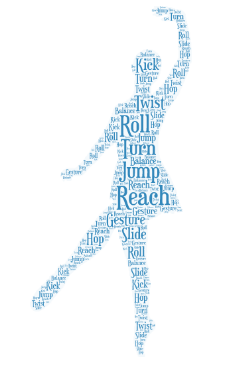Following the previous dance session, several of the feelings remained with me entering into the performance room. “In dance the ability to execute a sequence of movements based on stepping and turning demands technical control and skill, but placed within the context of a dance also requires creative understanding” (Bloomfield and Childs, 2000, p.4). My creative understanding began by learning the 10 basic dance moves that every dance educator should know (shown below) which I was pleasantly surprised with as these were manageable.
I enjoyed that we were given the opportunity to interpret each dance move ourselves instead of a strict, teacher-led lesson which reinforced the idea I had learned last week that having child-led activities was much more engaging and enjoyable. Cone (2011) also supported child-led activities as she found her dance students being actively engaged as their imagination was sparked by using their own interests and experiences to come up with themes for their dances. “Pupils are very responsive to curriculum content which is relevant to their interests and cultural experience” (Callaway and Kear, 2000b, p.96). This further challenged pupils to be spatially aware and “find solutions to movement” as Cone (2011) further discusses.
However, this enjoyment did not last as we soon had to create our own dance move from what we interpreted from the music being played. This also provided a useful interdisciplinary link as “the pitch and tone of music can link up with the spatial significance of dance as expressed through the directions of movement, whether through stepping, spinning, turning, rolling, leaping in ways that defy gravity or succumb to it” (Bloomsfield and Childs, 2000, p.51).
Creating our own dance moves instilled embarrassment within me as it meant I had to present to others. If this was replicated in the classroom with shy children, I think this would engage children much more as “watching, imagining, predicting as group formations disperse and re-form and spatial patterns expressed through gestures of limbs give rise to visual excitement and climax” (Bloomsfield and Childs, 2000, p.51).
Moreover, these dance moves were a part of a whole class routine which would be developed in the coming weeks. This allowed me to see how a routine and class production can be structured from basic dance moves and that anyone can do it as I observed everyone participating.
Drama is described as “inherently uncertain, ambiguous and frequently full of dramatic tension” (Jones and Wyse, 2013, p.83). My initial feelings to this art form were similar to that of dance as I have never enjoyed drama throughout my school experience as I always felt embarrassed and awkward to perform in front of peers. I also realise that several introverted children may have the same apprehensive feelings to drama that I do, as a future drama educator, it is important that I build up and research strategies to ensure everyone is enjoying and participating in drama as it is part of the curriculum.
During this session, we explored several dramatic techniques: teacher in role, process drama and freeze frame. What I found most interesting was process drama which “offers rich opportunities for creative development through the exploration of different possibilties and the adoption of different role perspectives” (Jones and Wyse, 2013, p.85). Process drama allowed us to control and manipulate the plot which makes it more personal, I think this would engage children much more as they are presented with the opportunity to have their ideas acted out.
This is backed up by Silverstein and Layne (2010) as they describe the importance of a “cooperative learning community” and enabling students to learn from each other which drama provides as children are constantly performing to their peers and teachers should continuously reflect and encourage children to improve.
I think “The Lonely Dragon” is a highly appropriate topic to do with children as it allows for a lot of input from children and improvisation which is an essential skill to develop and which I feel I lack in, which also factorises into my negative feelings towards performing. In participating in a role playing input, I took on the role of a villager which I tried to embrace as it was a small part and so I did not find this as intimidating as if I was to play a bigger role.
References
Bloomfield, A and Childs, J (2000) Teaching Integrated Arts in the Primary School: Dance, Drama, Music and the Visual Arts [Print] Great Britain: David Fulton
Callaway, G and Kear, M (eds) (2000b) Improving Teaching and Learning in the Arts [Print] London: Falmer Press
Lynne B. Silverstein and Sean Layne (2010) Defining Arts Integration, The John F. Kennedy Center for the Performing Arts.
Jones, R and Wyse, D (eds) (2013) Creativity in the Primary Curriculum (2nd ed) [Print] Oxon: Routledge
Theresa Purcell Cone (2009) Following Their Lead: Supporting Children’s Ideas for creating dances, Journal of Dance Education [Abstract, Online] Available: http:/dx.doi.org/10/1080/15290824.2009.10387390 [Accessed: 6/10/16].

